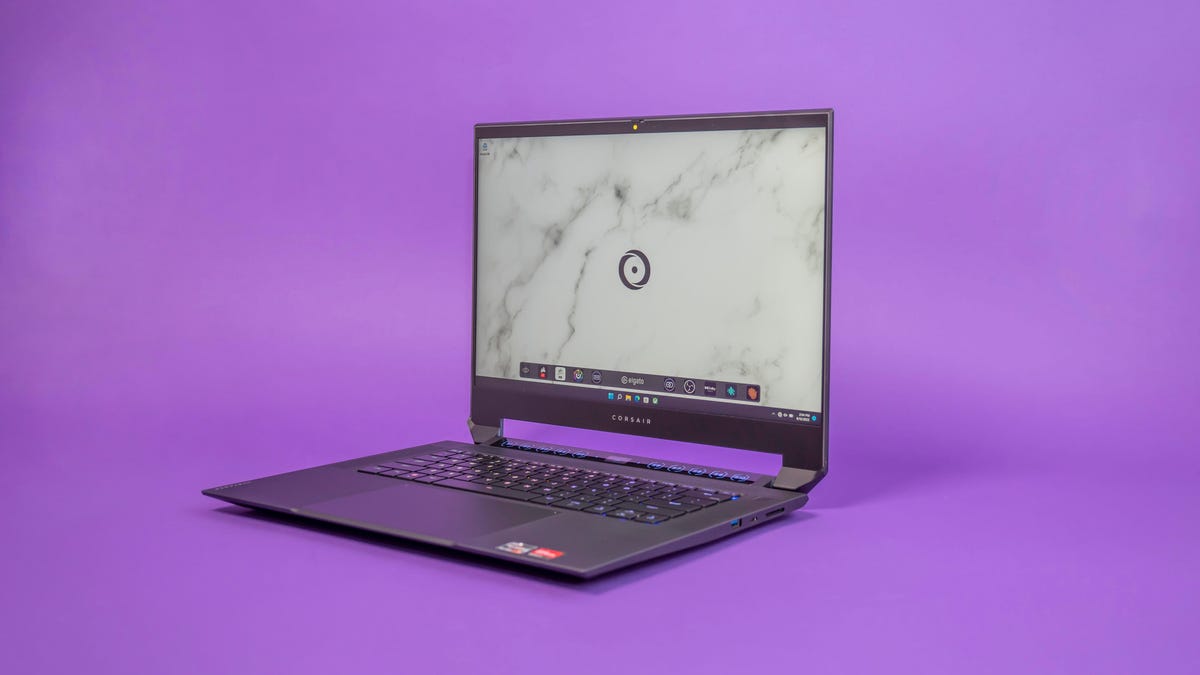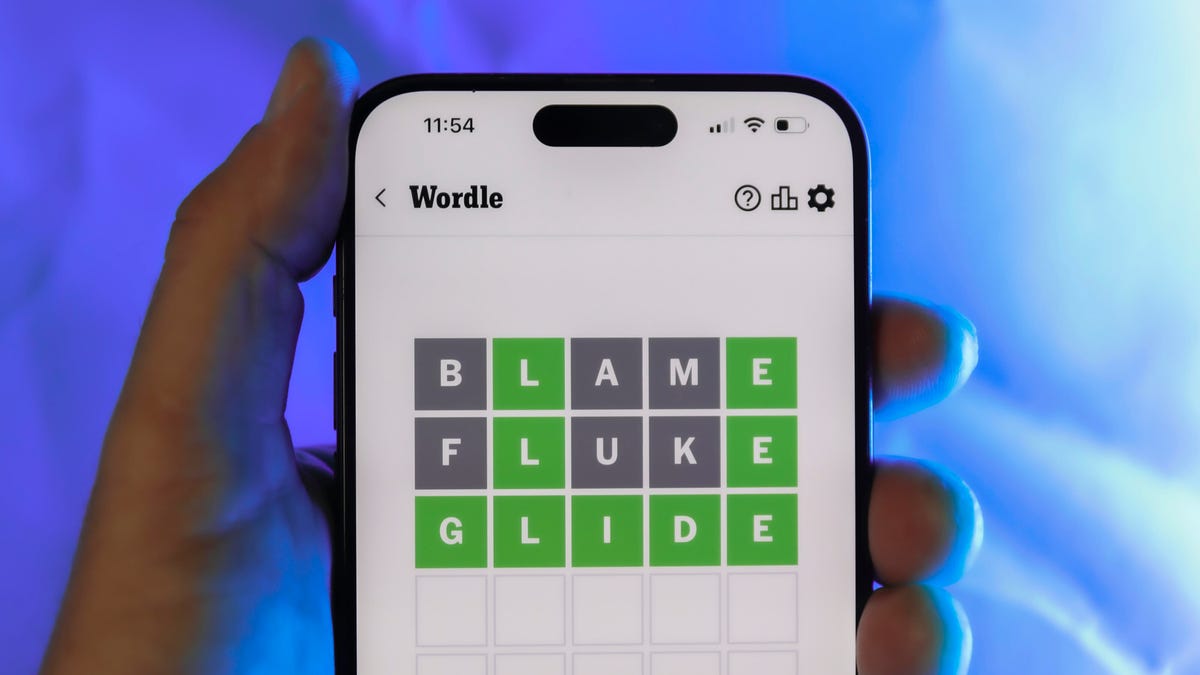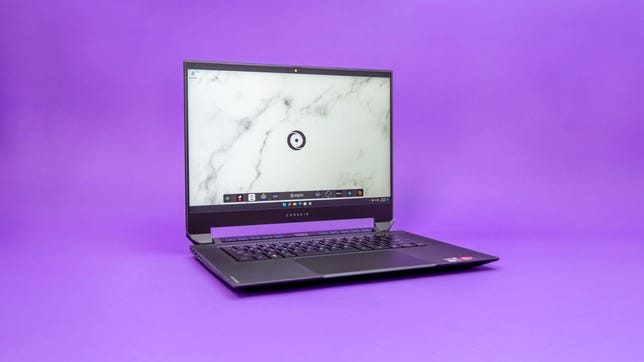Technologies
Corsair Voyager a1600 Review: This Gaming Laptop Has It All
Loaded with clever features you won’t find anywhere else, the Voyager is a treat for gamers, creators and streamers.

Corsair makes PC components, gaming accessories and gear for streamers. It also has a line of gaming desktops. The Corsair Voyager a1600 is its first gaming laptop and essentially combines all of the company’s product categories into one device.
The Voyager a1600 includes features from Corsair’s Elgato streaming hardware and software, RAM and storage from its components business and wireless tech from its gaming keyboards, mice and headsets. It’s a unique laptop made for gamers, creators and streamers.
With help from AMD, the Voyager a1600 has strong performance for gaming and creating, which is pretty great considering it’s only 19.8mm thick and weighs 5.3 pounds (2.4kg). The a1600 has also dramatically come down in price since its launch in late 2022, making it much easier to recommend for gamers looking to do it all from one laptop.
Like
- Unique compact design
- Built-in high-speed wireless for Corsair gaming accessories
- Low-profile mechanical keyboard
- Useful touch controls
Don’t Like
- Corsair’s software, system tools can be confusing
Great hardware
Corsair has four configurations for the Voyager a1600 starting at $2,000, with an AMD Ryzen 7 6800HS, AMD Radeon 6800M graphics, 16GB DDR5 memory and a 1TB NVMe solid-state drive. It runs on Windows 11 Home. That’s $700 less than the original price. There are more options, though.
Origin PC, a custom PC-maker owned by Corsair, also sells the Voyager a1600. If you buy from Origin, the Voyager can be configured to your liking with up to 64GB of RAM and one or two SSDs with a variety of models and capacities to choose from. You can even have its black lid covered with one of 11 patterns.
The configuration I tested combines the Ryzen 7, the Radeon 6800M, 32GB of memory and a fast 2TB Samsung SSD for $2,420, which includes $65 for the faux-marble lid treatment. That’s more than $600 less than its original price. The better deal, though, is direct from Corsair because you can bump up to the Ryzen 9 for $2,350.
The laptop I tested lived up to AMD’s performance claims. Start up a game and the discrete graphics take over, driving frame rates screaming up over 100 per second on Guardians of the Galaxy and Shadow of the Tomb Raider on high settings at 1440p in our testing. On CS:GO, the laptop can hit over 280fps so you take full advantage of the display’s 240Hz refresh rate.
Under load and with the fans on full blast, the Voyager stays cool on the left and right sides of the laptop, keeping your hands comfortable while gaming. It does get warm down the middle of the keyboard, particularly toward the top. The fans are loud, but that’s what you get with thin, powerful laptops.
The a1600 has a large 99Wh battery that lasted 5 hours, 4 minutes on our streaming video battery rundown test with both the display brightness and volume through earbuds set to 50%. Though it comes with a 230-watt adapter for gaming power and charging, the Voyager can be charged via USB-C with a 100-watt adapter.
All configurations come with a 240Hz, 2,560×1,600-pixel, 16-inch IPS display. It’s a good screen overall, especially if your main concerns are a high refresh rate for smooth graphics and easier target tracking with 1440p gaming. But if you need wide color gamut coverage, it only hits 75% of Adobe RGB and DCI-P3, 69% NTSC and 97% sRGB, and brightness measured at 359 nits. For those times when you need something brighter with better color reproduction, it does have three USB-C ports with Thunderbolt support for an external display or three.
The combo of the big 16:10 display and the oddly tall hinges give the body a peculiar appearance — and unusual dimensions for squeezing into a backpack’s laptop compartment. The cutout below the display is there to accommodate the S-Key Macro Bar, a strip of 10 programmable macro keys with a small color display between them. The bar works with Elgato’s Stream Deck software, letting you create macro keys with simple drag-and-drop programming for everything from using OBS streaming software to opening an app or website to playing a sound effect to triggering a voice changer.
For the keyboard, Corsair used ultralow-profile Cherry MX mechanical switches. The clicky switch gives you nice tactile feedback for typing and gaming. Even though the keys are clicky, they aren’t so loud that you’d disturb anyone around you. And, naturally, there are lights. The keyboard has per-key RGB lighting, completely programmable with Corsair’s iCue software.
The smooth touchpad below it is gigantic. So large, in fact, that tapping the upper right corner of it two times shuts down the right half of the touchpad so you don’t accidentally move your cursor with your palm while gaming. A double tap in the upper left corner shuts the pad down entirely.
However, if you don’t want to use either, a receiver for Corsair’s Slipstream Wireless-compatible peripherals is built in. It supports up to three devices at once so you can connect a mouse, keyboard and gaming headset without having to connect three separate USB receivers. It’s like having the convenience of Bluetooth but with the low-latency speed and stability of a 2.4GHz wireless receiver.
Software to match
All of the great hardware packed in the Voyager wouldn’t be nearly as strong if it didn’t have some handy software to go with it. The AMD Radeon Software: Adrenalin Edition, for instance, has several options to get the most from the CPU and integrated and discrete graphics. Activate AMD SmartShift Max and the laptop will automatically balance power between the components depending if you need more performance from the GPU or processor.
Similarly, SmartShift Eco saves battery life by using the integrated graphics when the laptop’s unplugged and moves back to the discrete graphics when connected to the power adapter. There are several other features to experiment with to improve performance on or off battery power, reduce input lag and sharpen image detail.
Joining the Elgato Stream Deck is Corsair’s iCue software from its gaming peripherals. This app is used for changing the keyboard lights, making key assignments and connecting Corsair wireless mice, keyboards and headsets. Then there’s the Elgato Camera Hub that lets you get control of the built-in 1080p webcam so you can adjust brightness, saturation, exposure and white balance. All of this software, while helpful, can be a bit much to manage, and it doesn’t feel cohesive.
The camera’s image quality is good, a little on the noisy side, but sharp with good detail. (There’s also an IR camera for unlocking the laptop with face recognition and a sliding privacy shutter to block the camera entirely.) Audio in and out is solid. The upward-firing speakers that flank the keyboard are supported by Dolby Atmos processing and have a pleasing, clean sound. They’ll be fine for casual listening or conference calls. But for anything else, you’ll want external speakers or a headset (a pair by Corsair, perhaps). The integrated mics delivered impressive results, so streamers will sound good without an external mic.
The Corsair Voyager a1600 is more than just a pure gaming machine. It’s an all-in-one portable solution for gamers and streamers, sure. But even if you’re not planning to stream gameplay or be a creator, the Stream Deck software and assignable macro buttons come in handy for everything from ending a Zoom call to launching Spotify. Plus, it includes a one-year warranty and lifetime 24/7 tech support service.
Technologies
Today’s NYT Mini Crossword Answers for Wednesday, Dec. 24
Here are the answers for The New York Times Mini Crossword for Dec. 24.

Looking for the most recent Mini Crossword answer? Click here for today’s Mini Crossword hints, as well as our daily answers and hints for The New York Times Wordle, Strands, Connections and Connections: Sports Edition puzzles.
Need some help with today’s Mini Crossword? I’m Irish-American, but yet 6-Down, which involves Ireland, stumped me at first. Read on for all the answers.. And if you could use some hints and guidance for daily solving, check out our Mini Crossword tips.
If you’re looking for today’s Wordle, Connections, Connections: Sports Edition and Strands answers, you can visit CNET’s NYT puzzle hints page.
Read more: Tips and Tricks for Solving The New York Times Mini Crossword
Let’s get to those Mini Crossword clues and answers.
Mini across clues and answers
1A clue: Wordle or Boggle
Answer: GAME
5A clue: Big Newton
Answer: ISAAC
7A clue: Specialized vocabulary
Answer: LINGO
8A clue: «See you in a bit!»
Answer: LATER
9A clue: Tone of many internet comments
Answer: SNARK
Mini down clues and answers
1D clue: Sharks use them to breathe
Answer: GILLS
2D clue: From Singapore or South Korea, say
Answer: ASIAN
3D clue: Large ocean ray
Answer: MANTA
4D clue: ___ beaver
Answer: EAGER
6D clue: Second-largest city in the Republic of Ireland, after Dublin
Answer: CORK
Don’t miss any of our unbiased tech content and lab-based reviews. Add CNET as a preferred Google source.
Technologies
Quadrantids Is a Short but Sweet Meteor Shower Just After New Year’s. How to See It
This meteor shower has one of the most active peaks, but it doesn’t last for very long.

The Quadrantids has the potential to be one of the most active meteor showers of the year, and skygazers won’t have long to wait to see it. The annual shower is predicted to reach maximum intensity on Jan. 3. And with a display that can rival Perseids, Quadrantids could be worth braving the cold to see it.
Don’t miss any of our unbiased tech content and lab-based reviews. Add CNET as a preferred Google source.
The show officially begins on Dec. 28 and lasts until Jan. 12, according to the American Meteor Society. Quadrantids is scheduled to peak on Jan. 2-3, when it may produce upwards of 125 meteors per hour. This matches Perseids and other larger meteor showers on a per-hour rate, but Quadrantids also has one of the shortest peaks at just 6 hours, so it rarely produces as many meteors overall as the other big ones.
The meteor shower comes to Earth courtesy of the 2003 EH1 asteroid, which is notable because most meteor showers are fed from comets, not asteroids. Per NASA, 2003 EH1 is a near-Earth asteroid that orbits the sun once every five and a half years. Science posits that 2003 EH1 was a comet in a past life, but too many trips around the sun stripped it of its ice, leaving only its rocky core. The Earth runs through EH1’s orbital debris every January, which results in the Quadrantids meteor shower.
How and where to see Quadrantids
Quadrantids is named for the constellation where its meteors appear to originate, a point known as the radiant. This presents another oddity, as the shower originates from the constellation Quadrans Muralis. This constellation ceased to be recognized as an official constellation in the 1920s and isn’t available on most publicly accessible sky maps.
For the modern skygazer, you’ll instead need to find the Bootes and Draco constellations, both of which contain stars that were once a part of the Quadrans Muralis. Draco will be easier to find after sunset on the evening of Jan. 2, and will be just above the horizon in the northern sky. Bootes orbits around Draco, but will remain under the horizon until just after 1 a.m. local time in the northeastern sky. From that point forward, both will sit in the northeastern part of the sky until sunrise. You’ll want to point your chair in that direction and stay there to see meteors.
As the American Meteor Society notes, Quadrantids has a short but active peak, lasting around 6 hours. The peak is expected to start around 4 p.m. ET and last well into the evening. NASA predicts the meteor shower to start one day later on Jan. 3-4, so if you don’t see any on the evening of Jan. 2, try again on Jan. 3.
To get the best results, the standard space viewing tips apply. You’ll want to get as far away from the city and suburbs as possible to reduce light pollution. Since it’ll be so cold outside, dress warmly and abstain from alcoholic beverages, as they can affect your body temperature. You won’t need any binoculars or telescopes, and the reduced field of view may actually impact your ability to see meteors.
The bad news is that either way, the Quadrantids meteor shower coincides almost perfectly with January’s Wolf Moon, which also happens to be a supermoon. This will introduce quite a lot of light pollution, which will likely drown out all but the brightest meteors. So, while it may have a peak of over 100 meteors per hour, both NASA and the AMS agree that the more realistic expectation is 10 or so bright meteors per hour.
Technologies
Today’s Wordle Hints, Answer and Help for Dec. 24, #1649
Here are hints and the answer for today’s Wordle for Dec. 24, No. 1,649.

Looking for the most recent Wordle answer? Click here for today’s Wordle hints, as well as our daily answers and hints for The New York Times Mini Crossword, Connections, Connections: Sports Edition and Strands puzzles.
Today’s Wordle puzzle is a little tricky, with a double letter that could confuse players. If you need a new starter word, check out our list of which letters show up the most in English words. If you need hints and the answer, read on.
Read more: New Study Reveals Wordle’s Top 10 Toughest Words of 2025
Today’s Wordle hints
Before we show you today’s Wordle answer, we’ll give you some hints. If you don’t want a spoiler, look away now.
Wordle hint No. 1: Repeats
Today’s Wordle answer has one repeated letter.
Wordle hint No. 2: Vowels
Today’s Wordle answer has one vowel, but it’s the repeated letter, so you’ll see it twice.
Wordle hint No. 3: First letter
Today’s Wordle answer begins with S.
Wordle hint No. 4: Last letter
Today’s Wordle answer ends with L.
Wordle hint No. 5: Meaning
Today’s Wordle answer can refer to a cylindrical device upon which thread is wound.
TODAY’S WORDLE ANSWER
Today’s Wordle answer is SPOOL.
Yesterday’s Wordle answer
Yesterday’s Wordle answer, Dec. 23, No. 1648 was GLINT.
Recent Wordle answers
Dec. 19, No. 1644: MYRRH
Dec. 20, No. 1645: WHITE
Dec. 21, No. 1646: QUILT
Dec. 22, No. 1647: CONCH
Don’t miss any of our unbiased tech content and lab-based reviews. Add CNET as a preferred Google source.
-

 Technologies3 года ago
Technologies3 года agoTech Companies Need to Be Held Accountable for Security, Experts Say
-

 Technologies3 года ago
Technologies3 года agoBest Handheld Game Console in 2023
-

 Technologies3 года ago
Technologies3 года agoTighten Up Your VR Game With the Best Head Straps for Quest 2
-

 Technologies4 года ago
Technologies4 года agoBlack Friday 2021: The best deals on TVs, headphones, kitchenware, and more
-

 Technologies4 года ago
Technologies4 года agoVerum, Wickr and Threema: next generation secured messengers
-

 Technologies4 года ago
Technologies4 года agoGoogle to require vaccinations as Silicon Valley rethinks return-to-office policies
-

 Technologies4 года ago
Technologies4 года agoOlivia Harlan Dekker for Verum Messenger
-

 Technologies4 года ago
Technologies4 года agoiPhone 13 event: How to watch Apple’s big announcement tomorrow

